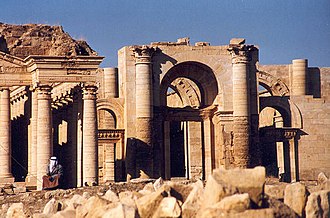Fall of Hatra
The fall of Hatra, capital of the Kingdom of Hatra under Sanatruq II, took place in the 3rd century after a lengthy siege by the Sasanian king Shapur I. Hatra was plundered and abandoned, and its kingdom dissolved.
Background
During the
Siege and aftermath
Modern sources put the date of Hatra's fall in 240–241 AD (or April 241 AD) per the newly discovered document
The siege was part of a "forgotten" Roman-Persian war at the second half of 230s. A small Roman garrison was probably stationed in the city, and was most likely destroyed.[4]
After the city's conquest, it was plundered, its fortifications were destroyed, the city was deserted and never resettled, and the Kingdom of Hatra was disestablished.[5][1] In 363, Ammianus Marcellinus passed by Hatra together with the Roman army and has described it as an "old city situated in an uninhabited area and deserted for a long time past".[1]
The fall of Hatra is described in medieval Arabic and Persian traditions via stories that mix facts and fiction. The legend tells of the Hatrene princess al-Nadirah who betrayed the city to Shapur I after falling in love with him.[1]
The Sasanian capture of Hatra is thought to be the cause of the Persian war of Gordian III.[6]
References
- ^ Encyclopaedia Iranica. Retrieved 16 March 2019.
- ^ Ibrāhīm, Jābir Khalīl (1986). Pre-Islamic settlement in Jazirah. Republic of Iraq, Ministry of Culture & Information, State Organization of Antiquities & Heritage. p. 107.
- ISBN 9781134095735.
- ^ Robert Suski: A Forgotten War. The Roman-Persian war in the second half of the 230s. In: Klio - Czasopismo Poświęcone Dziejom Polski i Powszechnym. Vol. 62, 2022, p. 3–18 (online).
- ^ Mid East. Vol. 7. American Friends of the Middle East. 1967. p. 56.
- Encyclopaedia Iranica.
Further reading
- Marcato, Enrico (2020). "An Aramaic Incantation Bowl and the Fall of Hatra". Journal of Ancient Near Eastern History. 7 (2): 133–157. S2CID 225421630.
